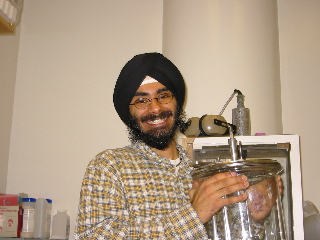
A Study of Phenylalanine Hydroxylase Inactivation in Wild-Type and PKU-Inducing Mutant Enzymes.
tel: (617) 358-0292
email: singh@bu.edu
B.A. - Honors Chemistry - Boston University
I am currently investigating the mechanism of the iron-dependent enzyme, phenylalanine hydroxylase (PAH), a liver enzyme that is responsible for maintaining phenylalanine homeostasis in humans. Defects in the PAH gene lead to the genetic defect, phenylketonuria (PKU), which is the most common inborn metabolic genetic disorder of clinical significance. Approximately 1:10,000 individuals suffer from PKU in the United States due to abnormal function of the phenylalanine hydroxylase (PAH) enzyme. PAH and missense mutations that give rise to PKU in the human population can now be readily expressed and investigated in a laboratory setting. Work in the Caradonna laboratory characterizing two missense mutations that cause PKU showed that the mutant forms of the enzyme were more susceptible to an inactivation process than the wildtype enzyme. This inactivation process is thought to be the direct consequence of irreversible specific side-chain oxidation chemistry induced by the nonproductive decay of the reactive intermediate normally generated to produce product. The abortive oxidation reaction would lead to overall inactivation of the enzyme. My project involves the use of liquid chromatography/mass spectroscopy techniques to investigate if any protein side chains are irreversibly modified during enzyme inactivation. A comparison of the data from wild-type PAH with inactivated PAH will allow me to determine exactly which residues are modified. Presently, these studies are being carried out in collaboration with the Mass Spectrometry Resource Center at the Boston University Medical School. This information, when coupled with structural data from crystallographic studies, will allow me to place the modification in the three dimensional structure. This is useful for understanding the mechanism of inactivation in PKU-causing mutant enzymes.
In addition to understanding enzyme inactivation, our laboratory is also in the process of isolating and characterizing the reactive intermediate species believed to be responsible for this enzyme’s overall chemistry. I am attempting to observe the presence of the intermediate iron-oxo species by using a poor substrate (para-F-phenylalanine) to slow the kinetics of the oxygen atom transfer step in the overall conversion of substrate to product. However, in order to analyze the inhibitory properties of this substrate in relation to the reactive species, it is first necessary to determine the binding affinity (Km) of para-F-Phe to PAH. Having successfully measured the Km for para-fluoro phenylalanine using UV-Vis spectroscopy, I can now analyze iron coordination using MCD spectroscopy. I will then follow the reaction using stopped-flow rapid kinetics spectroscopic methods and attempt to identify the presence of any kinetically competent intermediates.
With data available from both of these studies, a correct structure of the enzyme identifying the location of the inactive site in PKU-causing enzymes can be formed. With a deeper understanding of the underlying chemical defects found in PKU-inducing mutants, new approaches in the treatment of this type of disorder can hopefully follow.
Honors Program Graduate
2002 National Arnold and Mabel Beckman Scholarship
2001 Chemistry Mason Scholarship
2001 Undergraduate Research Opportunities Scholarship